The pip1s Quintuple Mutants Demonstrate the Essential Roles of PIP1s in the Plant Growth and Development of Arabidopsis
Abstract
:1. Introduction
2. Results
2.1. Generation of the pip1s− Quintuple Mutants in Arabidopsis Thaliana
2.2. The pip1s− Quintuple Mutants Are Defective in Plant Vegetative Growth
2.3. Mutation of PIP1s Affects Flower Growth and Development
2.4. Mutation of PIP1s Decreases the Number and Length of Silique
2.5. Mutation of PIP1s Affects Seed Development
2.6. Mutation of PIP1s Affects Pollen Morphology and Activity
2.7. Analysis of Differentially Expressed Genes (DEGs) in the pip1s− Mutants and the WT Plants
2.8. GO and KEGG Analyses of pip1s− Mutants and WT plants
2.9. Transcription Factor Analysis of the DEGs
2.10. Verification of Transcriptome Sequencing
3. Discussion
3.1. Mutation of PIP1s Influences the Vegetative Growth of Arabidopsis
3.2. Mutation of PIP1s Influences the Reproductive Growth of Arabidopsis
4. Materials and Methods
4.1. Plant Materials and Growth Conditions
4.2. Generation of the pip1s− Mutant
4.3. Identification of the pip1s− T-DNA Mutant
4.4. High-Throughput mRNA Sequencing Analysis
4.5. RNA Extraction and qRT-PCR
4.6. Statistical Analysis
5. Conclusions
Author Contributions
Funding
Data Availability Statement
Conflicts of Interest
References
- Maurel, C. Plant Aquaporins, Cell Biology; Springer: New York, NY, USA, 2014. [Google Scholar]
- Munns, R. Comparative physiology of salt and water stress. Plant Cell Environ. 2002, 25, 239–250. [Google Scholar] [CrossRef]
- Ueda, M.; Tsutsumi, N.; Fujimoto, M. Salt stress induces internalization of plasma membrane aquaporin into the vacuole in Ara-bidopsis thaliana. Biochem. Biophys. Res. Commun. 2016, 474, 742–746. [Google Scholar] [CrossRef] [PubMed] [Green Version]
- Blum, A. Effective use of water (EUW) and not water-use efficiency (WUE) is the target of crop yield improvement under drought stress. Field Crop. Res. 2009, 112, 119–123. [Google Scholar] [CrossRef]
- Hill, A.E.; Shachar-Hill, B.; Shachar-Hill, Y. What are aquaporins for? J. Membr. Biol. 2004, 197, 1–32. [Google Scholar] [CrossRef]
- Hélène, J.; Christophe, M. The role of aquaporins in root water uptake. Ann. Bot. 2002, 90, 301–313. [Google Scholar]
- Maurel, C.; Verdoucq, L.; Luu, D.-T.; Santoni, V. Plant aquaporins: Membrane channels with multiple integrated functions. Ann. Rev. Plant Biol. 2008, 59, 595–624. [Google Scholar] [CrossRef] [Green Version]
- Borgnia, M.; Nielsen, S.; Engel, A.; Agre, P. Cellular and Molecular Biology of the Aquaporin Water Channels. Annu. Rev. Biochem. 1999, 68, 425–458. [Google Scholar] [CrossRef] [PubMed]
- Boursiac, Y.; Chen, S.; Luu, D.-T.; Sorieul, M.; Dries, N.V.D.; Maurel, C. Early Effects of Salinity on Water Transport in Arabidopsis Roots. Molecular and Cellular Features of Aquaporin Expression. Plant Physiol. 2005, 139, 790–805. [Google Scholar] [CrossRef] [Green Version]
- Manu, V.; Mishtu, M.; Ramasubbu, S. Cooperativity in Plant Plasma Membrane Intrinsic Proteins (PIPs): Mechanism of Increased Water Transport in Maize PIP1 Channels in Hetero-tetramers. Sci. Rep. 2018, 8, 1–17. [Google Scholar]
- Verdoucq, L.; Maurel, C. Plant Aquaporins. Adv. Bot. Res. 2018, 87, 25–56. [Google Scholar] [CrossRef]
- Zhu Zhu, H.-L.Z. Plant aquaporins. Chin. J. Coll Biol. 2005, 27, 539–544. [Google Scholar]
- Tyerman, S.D.; Niemietz, C.M.; Bramley, H.H. Plant aquaporins: Multifunctional water and solute channels with expanding roles. Plant Cell Environ. 2010, 25, 173–194. [Google Scholar] [CrossRef] [PubMed] [Green Version]
- Postaire, O.; Tournaire-Roux, C.; Grondin, A.; Boursiac, Y.; Morillon, R.; Schäffner, A.R.; Maurel, C. A PIP1 Aquaporin Contributes to Hydrostatic Pressure-Induced Water Transport in Both the Root and Rosette of Arabidopsis. Plant Physiol. 2009, 152, 1418–1430. [Google Scholar] [CrossRef] [Green Version]
- Secchi, F.; Zwieniecki, M.A. The physiological response of Populus tremula x alba leaves to the down-regulation of PIP1 aquaporin gene expression under no water stress. Front. Plant Sci. 2013, 4, 507. [Google Scholar] [CrossRef] [Green Version]
- Hu, W.; Yuan, Q.; Wang, Y.; Cai, R.; Deng, X.; Wang, J.; Zhou, S.; Chen, M.; Chen, L.; Huang, C.; et al. Overexpression of a Wheat Aquaporin Gene, TaAQP8, Enhances Salt Stress Tolerance in Transgenic Tobacco. Plant Cell Physiol. 2012, 53, 2127–2141. [Google Scholar] [CrossRef] [Green Version]
- Liu, C.; Fukumoto, T.; Matsumoto, T.; Gena, P.; Frascaria, D.; Kaneko, T.; Katsuhara, M.; Zhong, S.; Sun, X.; Zhu, Y.; et al. Aquaporin OsPIP1:1 promotes rice salt resistance and seed germination. Plant Physiol. Biochem. 2013, 63, 151–158. [Google Scholar] [CrossRef] [PubMed]
- Suga, S.; Maeshima, M. Water Channel Activity of Radish Plasma Membrane Aquaporins Heterologously Expressed in Yeast and Their Modification by Site-Directed Mutagenesis. Plant Cell Physiol. 2004, 45, 823–830. [Google Scholar] [CrossRef] [PubMed]
- Ayadi, M.; Cavez, D.; Miled, N.; Chaumont, F.; Masmoudi, K. Identification and characterization of two plasma membrane aquaporins in durum wheat (Triticum turgidum L. subsp. durum) and their role in abiotic stress tolerance. Plant Physiol. Biochem. 2011, 49, 1029–1039. [Google Scholar] [CrossRef]
- Yaneff, A.; Vitali, V.; Amodeo, G. PIP1 aquaporins: Intrinsic water channels or PIP2 aquaporin modulators? FEBS Lett. 2015, 589, 3508–3515. [Google Scholar] [CrossRef] [Green Version]
- Fournier-Level, A.; Korte, A.; Cooper, M.D.; Nordborg, M.; Schmitt, J.; Wilczek, A.M. A map of local adaptation in Arabidopsis tha-liana. Science 2011, 334, 86–89. [Google Scholar] [CrossRef] [PubMed]
- Zelazny, E.; Borst, J.W.; Muylaert, M.; Batoko, H.; Hemminga, M.A.; Chaumont, F. FRET imaging in living maize cells reveals that plasma membrane aquaporins interact to regulate their subcellular localization. Proc. Natl. Acad. Sci. USA 2007, 104, 12359–12364. [Google Scholar] [CrossRef] [Green Version]
- Otto, B.; Uehlein, N.; Sdorra, S.; Fischer, M.; Ayaz, M.; Belastegui-Macadam, X.; Heckwolf, M.; Lachnit, M.; Pede, N.; Priem, N.; et al. Aquaporin Tetramer Composition Modifies the Function of Tobacco Aquaporins. J. Biol. Chem. 2010, 285, 31253–31260. [Google Scholar] [CrossRef] [PubMed] [Green Version]
- Jozefkowicz, C.; Sigaut, L.; Scochera, F.; Soto, G.; Ayub, N.; Pietrasanta, L.I.; Amodeo, G.; Flecha, F.L.G.; Alleva, K. PIP Water Transport and Its pH Dependence Are Regulated by Tetramer Stoichiometry. Biophys. J. 2016, 110, 1312–1321. [Google Scholar] [CrossRef] [Green Version]
- Yaneff, A.; Sigaut, L.; Marquez, M.; Alleva, K.; Pietrasanta, L.I.; Amodeo, G. Heteromerization of PIP aquaporins affects their intrinsic permeability. Proc. Natl. Acad. Sci. USA 2013, 111, 231–236. [Google Scholar] [CrossRef] [PubMed] [Green Version]
- Maurel, C. Plant aquaporins: Novel functions and regulation properties. FEBS Lett. 2007, 581, 2227–2236. [Google Scholar] [CrossRef]
- Gomes, D.; Agasse, A.; Thiébaud, P.; Delrot, S.; Gerós, H.; Chaumont, F. Aquaporins are multifunctional water and solute transporters highly divergent in living organisms. Biochim. Biophys. Acta Biomembr. 2009, 1788, 1213–1228. [Google Scholar] [CrossRef] [PubMed] [Green Version]
- Lian, H.-L.; Yu, X.; Ye, Q.; Ding, X.-S.; Kitagawa, Y.; Kwak, S.-S.; Su, W.-A.; Tang, Z.-C. The Role of Aquaporin RWC3 in Drought Avoidance in Rice. Plant Cell Physiol. 2004, 45, 481–489. [Google Scholar] [CrossRef] [PubMed] [Green Version]
- Vera-Estrella, R.; Barkla, B.J.; Bohnert, H.J.; Pantoja, O. Novel Regulation of Aquaporins during Osmotic Stress. Plant Physiol. 2004, 135, 2318–2329. [Google Scholar] [CrossRef] [Green Version]
- Ji, Y.J.; Dong, G.K.; Kim, Y.O.; Jin, S.K.; Kang, H. An expression analysis of a gene family encoding plasma membrane aqua-porins in response to abiotic stresses in Arabidopsis thaliana. Plant Mol. Biol. 2004, 54, 713–725. [Google Scholar]
- Fricke, W.; Akhiyarova, G.; Wei, W.; Alexandersson, E.; Miller, A.; Kjellbom, P.O.; Richardson, A.; Wojciechowski, T.; Schreiber, L.; Veselov, D.; et al. The short-term growth response to salt of the developing barley leaf. J. Exp. Bot. 2006, 57, 1079–1095. [Google Scholar] [CrossRef] [Green Version]
- Horie, T.; Kaneko, T.; Sugimoto, G.; Sasano, S.; Panda, S.K.; Shibasaka, M.; Katsuhara, M. Mechanisms of Water Transport Mediated by PIP Aquaporins and Their Regulation Via Phosphorylation Events Under Salinity Stress in Barley Roots. Plant Cell Physiol. 2011, 52, 663–675. [Google Scholar] [CrossRef] [PubMed]
- Chaumont, F.; Moshelion, M.; Daniels, M.J. Regulation of plant aquaporin activity. Biol. Cell 2005, 97, 749–764. [Google Scholar] [CrossRef] [Green Version]
- Bienert, G.P.; Schjoerring, J.K.; Jahn, T.P. Membrane transport of hydrogen peroxide. Biochim. Biophys. Acta 2006, 1758, 994–1003. [Google Scholar] [CrossRef] [Green Version]
- Alexandersson, E.; Fraysse, L.; Sjövall-Larsen, S.; Gustavsson, S.; Fellert, M.; Karlsson, M.; Johanson, U.; Kjellbom, P. Whole Gene Family Expression and Drought Stress Regulation of Aquaporins. Plant Mol. Biol. 2005, 59, 469–484. [Google Scholar] [CrossRef]
- Mahdieh, M.; Mostajeran, A.; Horie, T.; Katsuhara, M. Drought stress alters water relations and expression of PIP-type aq-uaporin genes in Nicotiana tabacum plants. Plant Cell Physiol. 2008, 49, 801–813. [Google Scholar] [CrossRef]
- Cui, X.-H.; Hao, F.-S.; Chen, H.; Chen, J.; Wang, X.-C. Expression of the Vicia faba VfPIP1 gene in Arabidopsis thaliana plants improves their drought resistance. J. Plant Res. 2008, 121, 207–214. [Google Scholar] [CrossRef]
- Zhou, L.; Wang, C.; Liu, R.; Han, Q.; Vandeleur, R.K.; Du, J.; Tyerman, S.; Shou, H. Constitutive overexpression of soybean plasma membrane intrinsic protein GmPIP1;6 confers salt tolerance. BMC Plant Biol. 2014, 14, 181. [Google Scholar] [CrossRef] [PubMed] [Green Version]
- Guo, L.; Wang, Z.Y.; Lin, H.; Cui, W.E.; Chen, J.; Liu, M.; Chen, Z.L.; Qu, L.J.; Gu, H. Expression and functional analysis of the rice plasma-membrane intrinsic protein gene family. Cell Res. 2006, 16, 277–286. [Google Scholar] [CrossRef]
- Peng, Y.H.; Arora, R.; Li, G.W.; Wang, X.; Fessehaie, A. Rhododendron catawbiense plasma membrane intrinsic proteins are aquaporins, and their overexpression compromises constitutive freezing tolerance and cold acclimation ability of transgenic Arabidopsis plants. Plant Cell Environ. 2008, 31, 1275–1289. [Google Scholar] [CrossRef]
- Zhou, S.; Hu, W.; Deng, X.; Ma, Z.; Chen, L.; Huang, C.; Wang, C.; Wang, J.; He, Y.; Yang, G.; et al. Overexpression of the Wheat Aquaporin Gene, TaAQP7, Enhances Drought Tolerance in Transgenic Tobacco. PLoS ONE 2012, 7, e52439. [Google Scholar] [CrossRef] [PubMed] [Green Version]
- Hanba, Y.T.; Shibasaka, M.; Hayashi, Y.; Hayakawa, T.; Kasamo, K.; Terashima, I.; Katsuhara, M. Overexpression of the Barley Aquaporin HvPIP2;1 Increases Internal CO2 Conductance and CO2 Assimilation in the Leaves of Transgenic Rice Plants. Plant Cell Physiol. 2004, 45, 521–529. [Google Scholar] [CrossRef] [PubMed] [Green Version]
- Geng, H.; Shi, L.; Li, W.; Zhang, B.; Chu, C.; Li, H.; Zhang, G. Gene expression of jojoba (Simmondsia chinensis) leaves exposed to drying. Environ. Exp. Bot. 2008, 63, 137–146. [Google Scholar] [CrossRef]
- Zhang, L.; Xiao, S.; Li, W.; Feng, W.; Li, J.; Wu, Z.; Gao, X.; Liu, F.; Shao, M. Overexpression of a Harpin-encoding gene hrf1 in rice enhances drought tolerance. J. Exp. Bot. 2011, 62, 4229–4238. [Google Scholar] [CrossRef] [Green Version]
- Schröder, F.; Lisso, J.; Müssig, C. Expression pattern and putative function of EXL1 and homologous genes in Ara-bidopsis. Plant Signal. Behav. 2012, 7, 22–27. [Google Scholar] [CrossRef] [PubMed] [Green Version]
- Schröder, F.; Lisso, J.; Müssig, C. EXORDIUM-LIKE1 Promotes Growth during Low Carbon Availability in Arabidopsis. Plant Physiol. 2011, 156, 1620–1630. [Google Scholar] [CrossRef] [PubMed] [Green Version]
- Renault, H.; Amrani, A.E.; Berger, A.; Mouille, G.; Soubigou-Taconnat, L.; Boucherau, A.; Deleu, C. γ-Aminobutyric acid transaminase deficiency impairs central carbon metabolism and leads to cell wall defects during salt stress in Arabidopsis roots. Plant Cell Environ. 2013, 36, 1009–1018. [Google Scholar] [CrossRef] [PubMed]
- Hu, B.; Liu, B.; Liu, L.; Liu, C.; Xu, L.; Ruan, Y. Epigenetic control of Pollen Ole e 1 allergen and extensin family gene expression in Arabidopsis thaliana. Acta Physiol. Plant. 2014, 36, 2203–2209. [Google Scholar] [CrossRef]
- Li, F.; Wu, X.; Lam, P.; Bird, D.; Zheng, H.; Samuels, L.; Jetter, R.; Kunst, L. Identification of the wax ester synthase/acyl-coenzyme A: Diacylglycerol acyltransferase WSD1 required for stem wax ester biosynthesis in Arabidopsis. Plant Physiol. 2008, 148, 97–107. [Google Scholar] [CrossRef] [Green Version]
- Patwari, P.; Salewski, V.; Gutbrod, K.; Kreszies, T.; Dressen-Scholz, B.; Peisker, H.; Steiner, U.; Meyer, A.J.; Schreiber, L.; Dörmann, P. Surface wax esters contribute to drought tolerance in Arabidopsis. Plant J. 2019, 98, 727–744. [Google Scholar] [CrossRef] [PubMed]
- Park, C.S.; Go, Y.S.; Suh, M.C. Cuticular wax biosynthesis is positively regulated by WRINKLED4, an AP2/ERF-type transcription factor, in Arabidopsis stems. Plant J. 2016, 88, 257–270. [Google Scholar] [CrossRef] [PubMed]
- Duan, H.; Huang, M.-Y.; Palacio, K.; Schuler, M.A. Variations in CYP74B2 (Hydroperoxide Lyase) Gene Expression Differentially Affect Hexenal Signaling in the Columbia and Landsberg erecta Ecotypes of Arabidopsis1[w]. Plant Physiol. 2005, 139, 1529–1544. [Google Scholar] [CrossRef] [Green Version]
- Kushiro, T.; Okamoto, M.; Nakabayashi, K.; Yamagishi, K.; Kitamura, S.; Asami, T.; Hirai, N.; Koshiba, T.; Kamiya, J.; Nambara, E. The Arabidopsis cytochrome P450 CYP707A encodes ABA 8′-hydroxylases: Key enzymes in ABA catabolism. EMBO J. 2014, 23, 1647–1656. [Google Scholar] [CrossRef] [Green Version]
- Nakashima, K.; Yamaguchi-Shinozaki, K. Promoters and Transcription Factors in Abiotic Stress-Responsive Gene Expression. In Abiotic Stress Adaptation in Plants; Springer: Dordrecht, Germany, 2009; pp. 199–216. [Google Scholar]
- Pareek, A.; Sopory, S.K.; Bohnert, H.J. Abiotic Stress Adaptation in Plants. Photosynthetica. 2010, 48, 474. [Google Scholar]
- Jensen, M.K.; Kjaersgaard, T.; Petersen, K.; Skriver, K. NAC genes: Time-specific regulators of hormonal signaling in Arabidopsis. Plant Signal. Behav. 2010, 5, 907–910. [Google Scholar] [CrossRef] [Green Version]
- Ferro, M.; Brugière, S.; Salvi, D.; Seigneurin-Berny, D.; Court, M.; Moyet, L.; Ramus, C.; Miras, S.; Mellal, M.; Le Gall, S.; et al. AT_CHLORO, a Comprehensive Chloroplast Proteome Database with Subplastidial Localization and Curated Information on Envelope Proteins. Mol. Cell. Proteom. 2010, 9, 1063–1084. [Google Scholar] [CrossRef] [Green Version]
- Simm, S.; Papasotiriou, D.G.; Ibrahim, M.; Leisegang, M.S.; Müller, B.; Schorge, T.; Karas, M.; Mirus, O.; Sommer, M.S.; Schleiff, E. Defining the Core Proteome of the Chloroplast Envelope Membranes. Front. Plant Sci. 2013, 4, 11. [Google Scholar] [CrossRef] [Green Version]
- Zybailov, B.; Rutschow, H.; Friso, G.; Rudella, A.; Emanuelsson, O.; Sun, Q.; van Wijk, K.J. Sorting signals, N-terminal modifications and abundance of the chloroplast proteome. PLoS ONE 2008, 3, e1994. [Google Scholar] [CrossRef] [PubMed] [Green Version]
- Beebo, A.; Mathai, J.C.; Schoefs, B.; Spetea, C. Assessment of the requirement for aquaporins in the thylakoid membrane of plant chloroplasts to sustain photosynthetic water oxidation. FEBS Lett. 2013, 587, 2083–2089. [Google Scholar] [CrossRef] [PubMed] [Green Version]
- Flexas, J.; Ribas-Carbó, M.; Hanson, D.T.; Bota, J.; Otto, B.; Cifre, J.; McDowell, N.G.; Medrano, H.; Kaldenhoff, R. Tobacco aquaporin NtAQP1 is involved in mesophyll conductance to CO2in vivo. Plant J. 2006, 48, 427–439. [Google Scholar] [CrossRef] [PubMed]
- Shatil-Cohen, A.; Attia, Z.; Moshelion, M. Bundle-sheath cell regulation of xylem-mesophyll water transport via aquaporins under drought stress: A target of xylem-borne ABA? Plant J. 2011, 67, 72–80. [Google Scholar] [CrossRef]
- Siefritz, F.; Tyree, M.T.; Lovisolo, C.; Schubert, A.; Kaldenhoff, R. PIP1 plasma membrane aquaporins in tobacco: From cellular effects to function in plants. Plant Cell 2002, 14, 869–876. [Google Scholar] [CrossRef] [PubMed] [Green Version]
- Uehlein, N.; Otto, B.; Hanson, D.T.; Fischer, M.; McDowell, N.; Kaldenhoff, R. Function of Nicotiana tabacum aquaporins as chlo-roplast gas pores challenges the concept of membrane CO2 permeability. Plant Cell 2008, 20, 648–657. [Google Scholar] [CrossRef] [Green Version]
- Heckwolf, M.; Pater, D.; Hanson, D.T.; Kaldenhoff, R. The Arabidopsis thaliana aquaporin AtPIP1;2 is a physio-logically relevant CO2 transport facilitator. Plant J. 2011, 67, 795–804. [Google Scholar] [CrossRef] [PubMed]
- Soto, G.; Alleva, K.; Mazzella, M.A.; Amodeo, G.; Muschietti, J.P. AtTIP1:3 and AtTIP5:1, the only highly expressed Arabidopsis pollen-specific aquaporins, transport water and urea. FEBS Lett. 2008, 582, 4077–4082. [Google Scholar] [CrossRef] [Green Version]
- Vander Willigen, C.; Postaire, O.; Tournaire-Roux, C.; Boursiac, Y.; Maurel, C. Expression and inhibition of aquaporins in germi-nating Arabidopsis seeds. Plant Cell Physiol. 2006, 47, 1241–1250. [Google Scholar] [CrossRef] [PubMed] [Green Version]
- Wudick, M.M.; Luu, D.T.; Tournaire-Roux, C.; Sakamoto, W.; Maurel, C. Vegetative and Sperm Cell-Specific Aquaporins of Arabidopsis Highlight the Vacuolar Equipment of Pollen and Contribute to Plant Reproduction1[W]. Plant Physiol. 2014, 164, 1697–1706. [Google Scholar] [CrossRef] [PubMed] [Green Version]
- Bots, M.; Vergeldt, F.; Wolters-Arts, M.; Weterings, K.; Van As, H.; Mariani, C. Aquaporins of the PIP2 Class Are Required for Efficient Anther Dehiscence in Tobacco. Plant Physiol. 2005, 137, 1049–1056. [Google Scholar] [CrossRef] [PubMed] [Green Version]
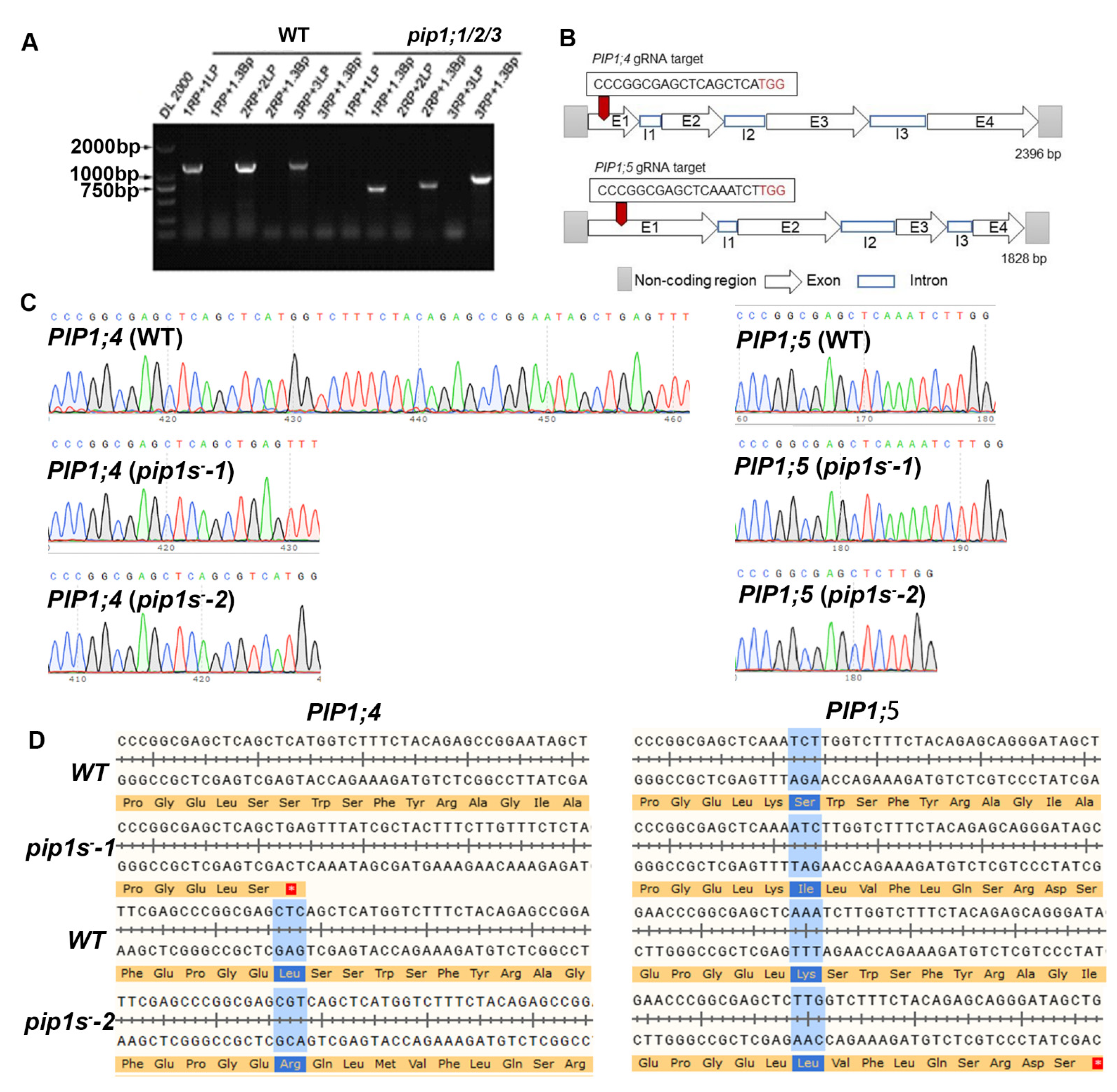
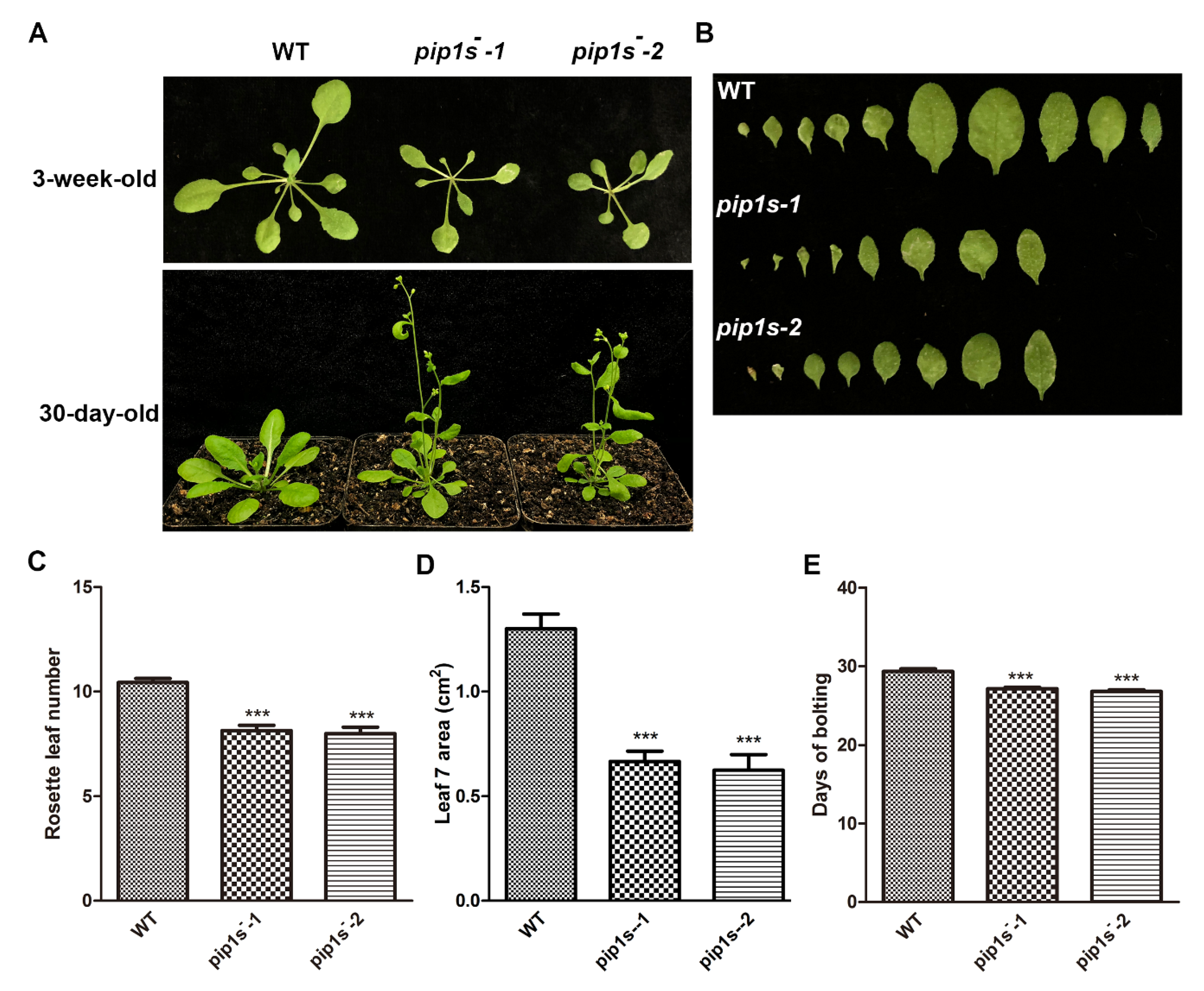
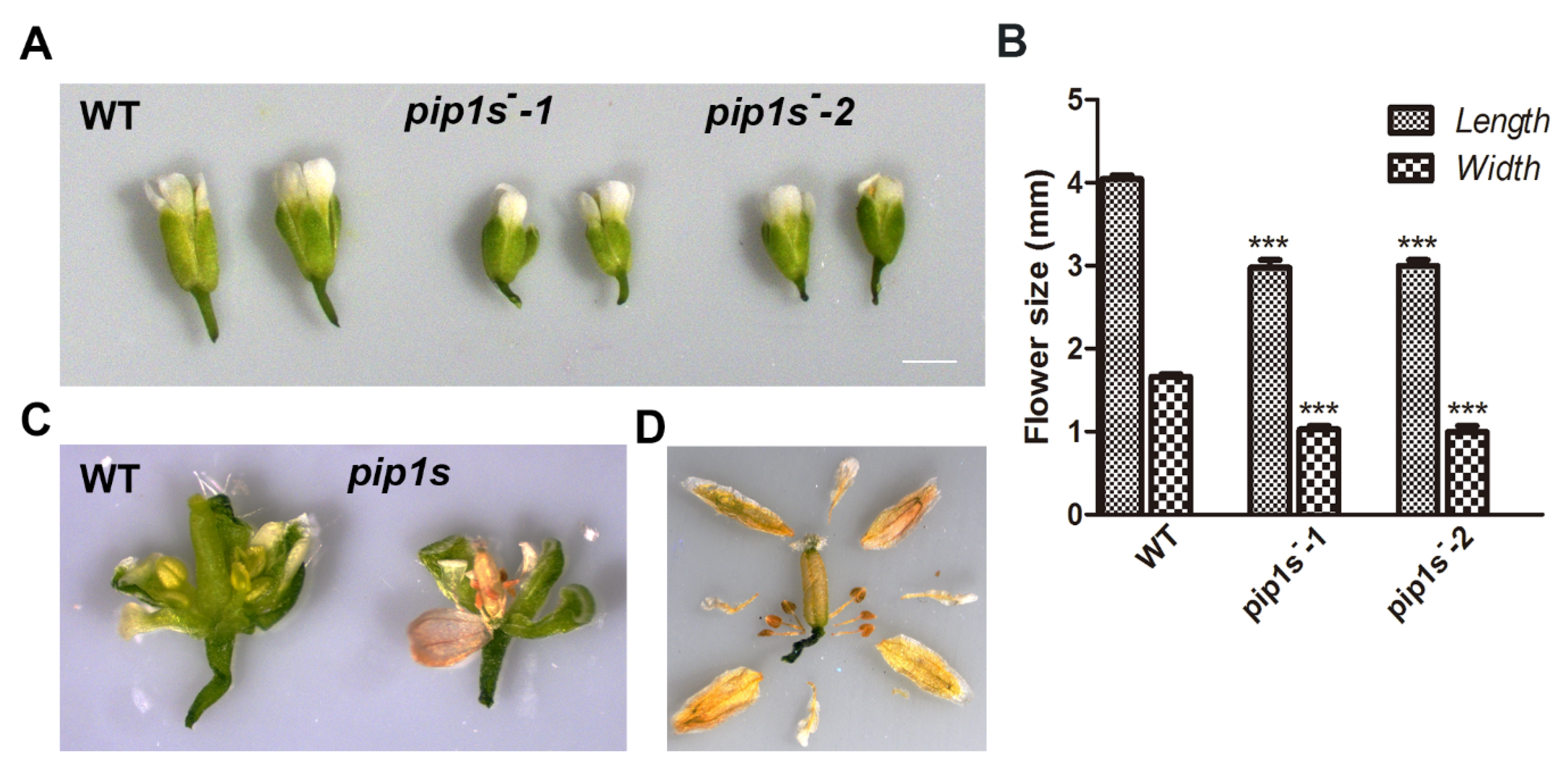
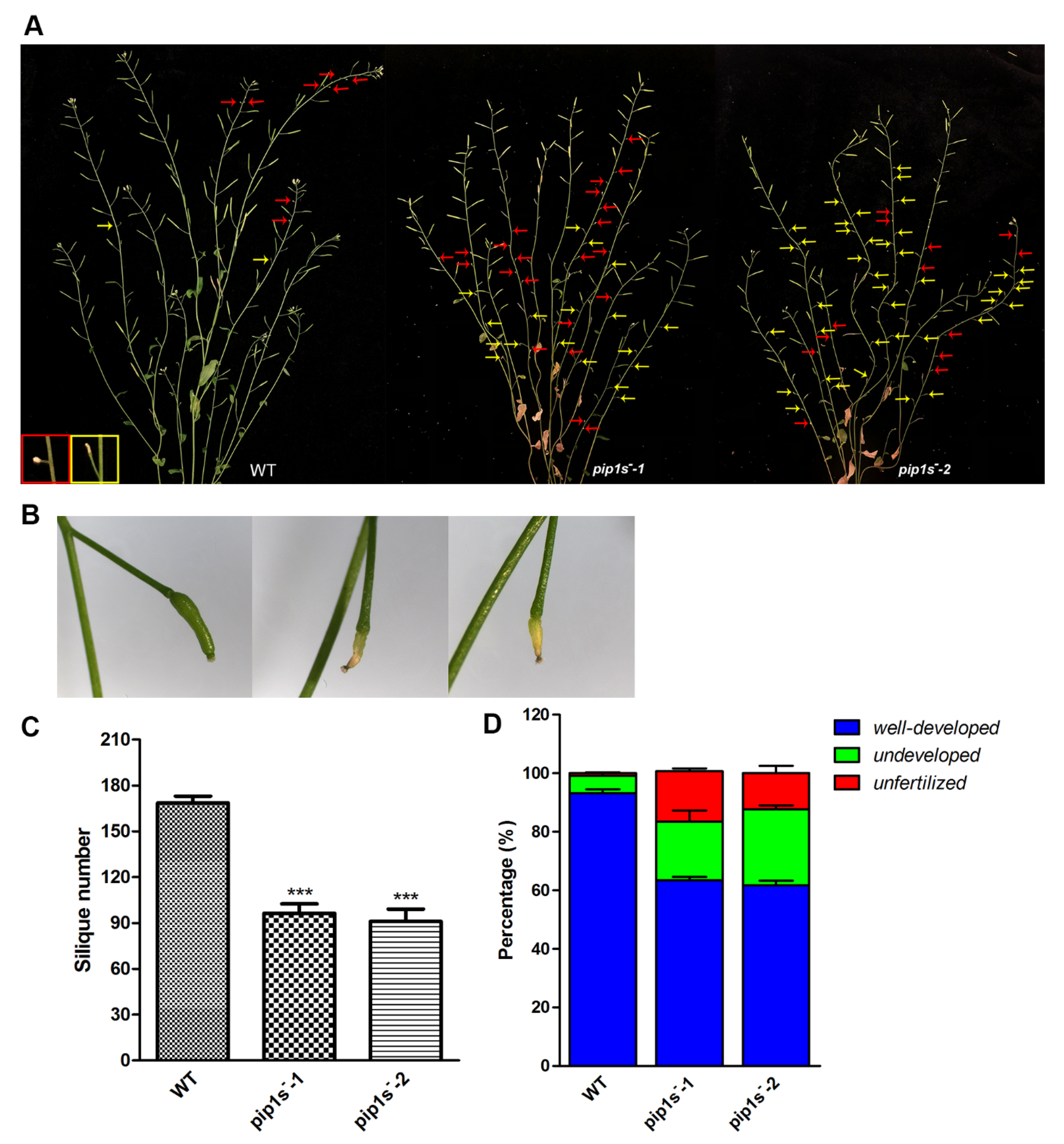
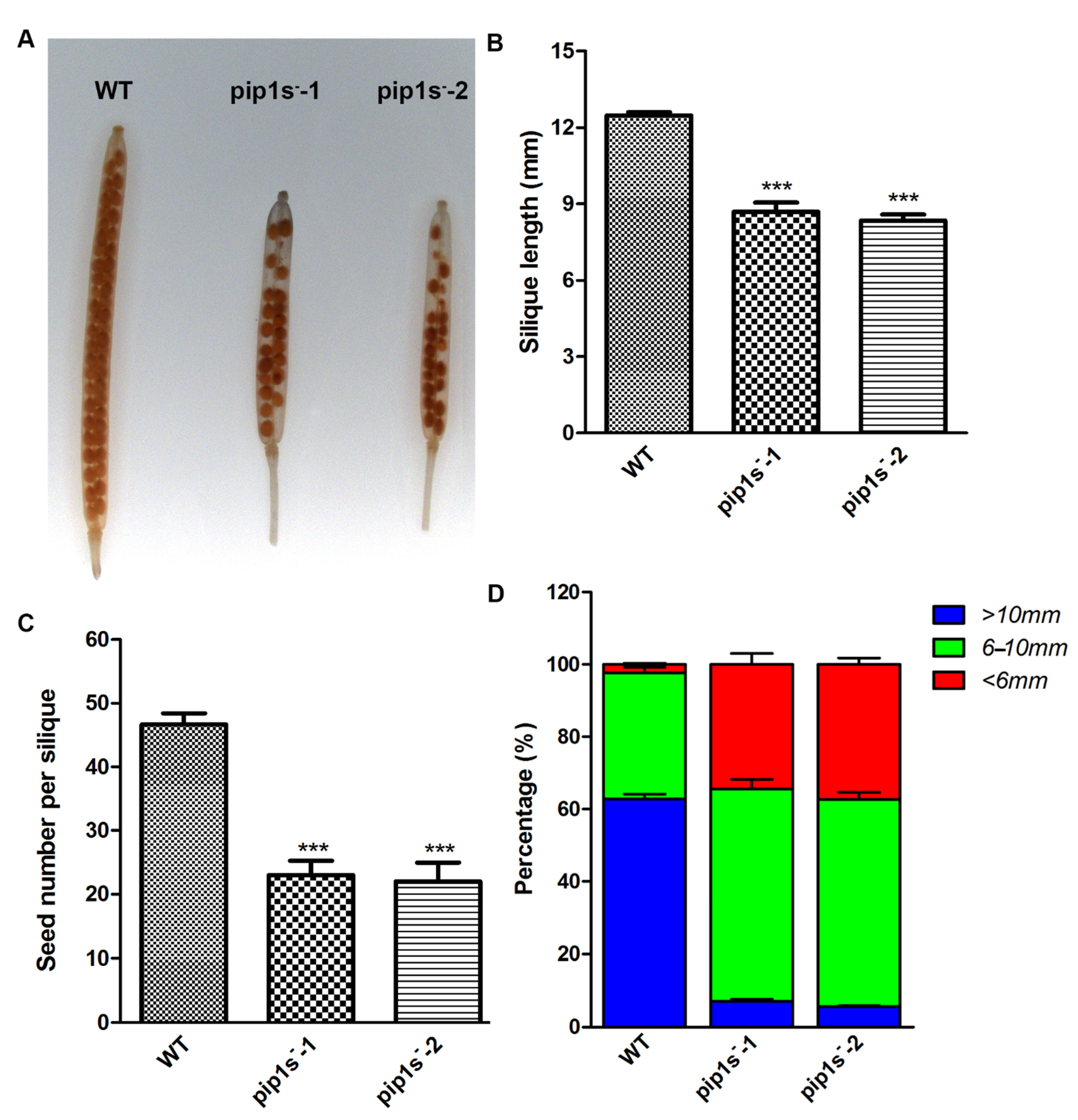
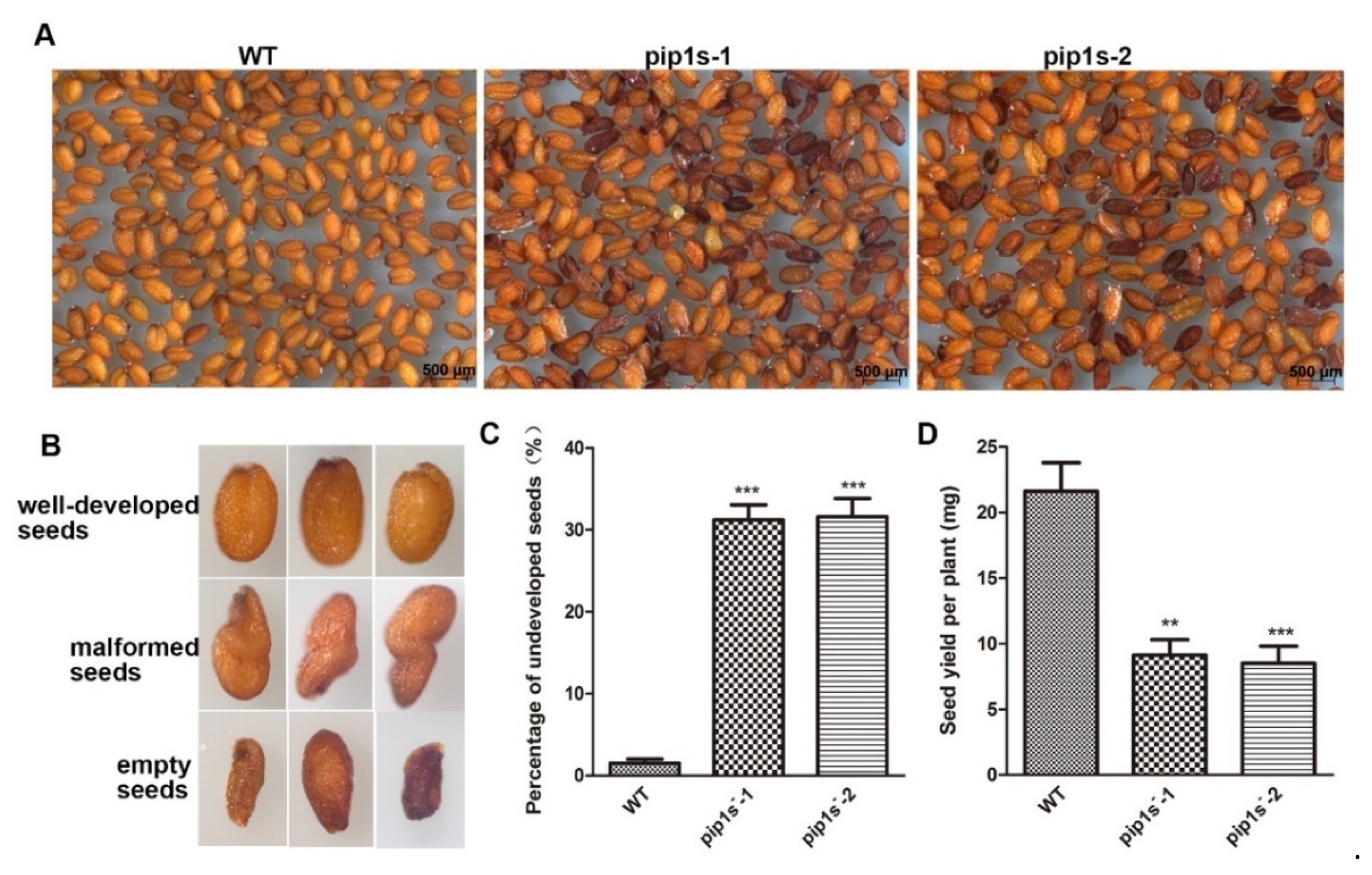



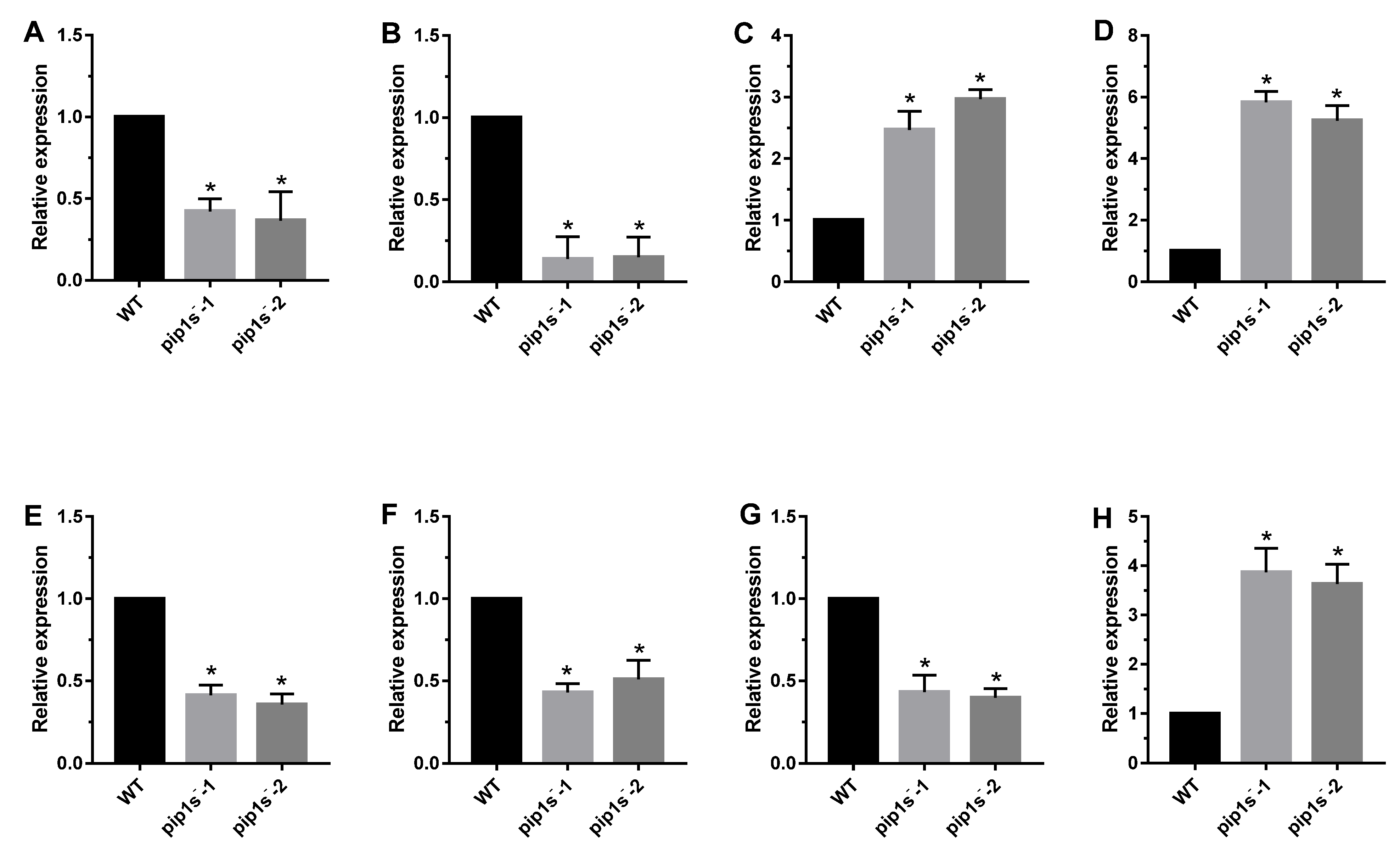
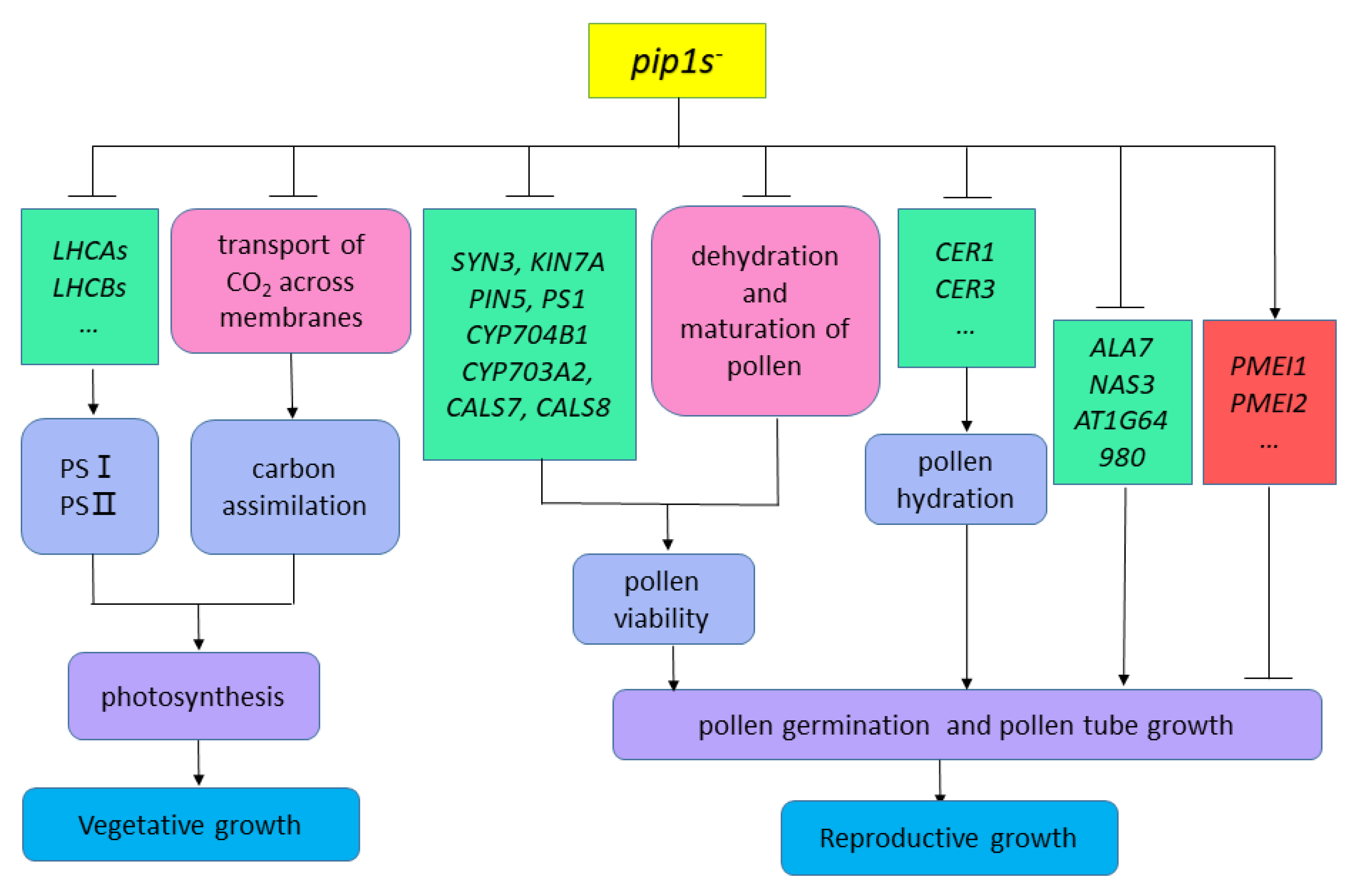
| Gene ID | Gene Name | Description | Mutant Count | WT Count | Log2Fold Change | Padj |
|---|---|---|---|---|---|---|
| AT3G54890 | LHCA1 | Chlorophyll a/b binding protein, as a light harvesting protein complex in photosystem (PS) I or II, which converts light energy into unstable chemical energy. | 15,708 | 39,004 | −1.19727 | 0 |
| AT1G61520 | LHCA3 | 19,795 | 43,290 | −1.01405 | 0 | |
| AT3G47470 | LHCA4 | 22,052 | 66,725 | −1.48247 | 0 | |
| AT1G29920 | LHCB1.1 | 5349 | 82,295 | −3.82861 | 0 | |
| AT2G05100 | LHCB2.1 | 2706 | 46,267 | −3.9809 | 0 | |
| AT5G54270 | LHCB3 | 8926 | 51,223 | −2.40585 | 0 | |
| AT3G08940 | LHCB4.2 | 10,934 | 25,689 | −1.11748 | 0 | |
| AT4G20050 | QRT3 | Encodes a polygalacturonase that plays a direct role in degrading the pollen mother cell wall. | 159 | 570 | −1.72708 | 8.15 × 10−48 |
| AT1G69500 | CYP704B1 | Encodes a cytochrome P450, designated CYP704B1. Expressed in the developing anthers. Essential for pollen exine development. | 84 | 193 | −1.08529 | 4.44 × 10−9 |
| AT1G01280 | CYP703A2 | Catalyzes the in-chain hydroxylation of medium-chain saturated fatty acids which is involved in pollen development. | 78 | 181 | −1.09959 | 9.40 × 10−9 |
| AT1G06490 | CALS7 | Callose synthesis gene, its deletion causes the normal development of the outer wall of pollen to be blocked. | 18 | 54 | −1.55859 | 2.80 × 10−5 |
| AT3G14570 | CALS8 | 37 | 85 | −1.17356 | 2.34 × 10-5 | |
| AT1G63910 | AtMYB103 | Regulate CALS expression to regulate pollen tapetum development and callose degradation. | 46 | 107 | −1.10305 | 9.13 × 10−6 |
| AT3G59550 | SYN3 | Core components of meiotic and mitotic cohesin complexes, which plays an important role in pollen development. | 11 | 26 | −1.21464 | 0.012428 |
| AT1G18370 | KIN7A | Encodes a kinesin HINKEL and are required for cytokinesis in pollen. | 4 | 36 | −3.14355 | 1.72 × 10−7 |
| AT5G16530 | PIN5 | Acts together with PIN8 in affecting pollen development and auxin homeostasis. | 38 | 94 | −1.28029 | 1.98 × 10−6 |
| AT1G34355 | PS1 | Mutations in PS1 lead to diploid male spores, diploid pollen grains, and spontaneous triploid plants in the next generation. | 3 | 19 | −2.63659 | 0.000449 |
| AT1G02205 | CER1 | Involved in the synthesis and transport of lipids in the oil-bearing layer, necessary for the signal transduction mechanism of pollen and stigma hydration. | 4284 | 10,773 | −1.21554 | 0 |
| AT5G57800 | CER3 | 5072 | 11,925 | −1.11851 | 0 | |
| AT1G09240 | NAS3 | Encodes a nicotianamine synthase, which involved in pollen tube growth. | 46 | 239 | −2.26245 | 4.47 × 10−29 |
| AT3G13900 | ALA7 | Encodes a P-type ATPases expressed in the pollen plasma membrane. Double mutants with ALA6 display pollen and pollen tube defects. | 74 | 260 | −1.69806 | 5.33 × 10−22 |
| AT1G64980 | AT1G64980 | Encodes a putative nucleotide-diphospho-sugar transferase required for pollen germination and tube growth. | 590 | 1476 | −1.29653 | 7.03 × 10−83 |
| AT3G62180 | AT3G62180 | Pectin methyl esterase inhibitor, located at the top of pollen tube cells, negatively regulates catalysis. | 8 | 1 | 3.026373 | 0.011036 |
| AT1G48020 | PMEI1 | 18 | 5 | 1.87437 | 0.004514 | |
| AT3G17220 | PMEI2 | 11 | 2 | 2.485805 | 0.007609 |
| Pathway | Up Count | Down Count | q-Value | |
|---|---|---|---|---|
| muleaf vs. WTleaf | Plant hormone signal transduction | 26 | 21 | 0.000195 |
| Phenylpropanoid biosynthesis | 15 | 12 | 0.025966 | |
| Flavonoid biosynthesis | 6 | 3 | 0.016017 | |
| DNA replication | 0 | 12 | 0.019096 | |
| musili vs. WTsili | Phenylpropanoid biosynthesis | 15 | 23 | 2.52 × 10−7 |
| Cutin, suberine and wax biosynthesis | 6 | 12 | 0.000055 | |
| Pentose and glucuronate interconversions | 21 | 1 | 2.51 × 10−5 | |
| Starch and sucrose metabolism | 15 | 7 | 0.043843 | |
| Circadian rhythm—plant | 5 | 7 | 0.000399 | |
| Photosynthesis—antenna proteins | 0 | 7 | 0.003608 | |
| Flavonoid biosynthesis | 3 | 5 | 0.019055 |
| Gene ID | Gene Name | TF Family | GO | Muleaf Count | WTleaf Count | Log2Fold Change | Padj |
|---|---|---|---|---|---|---|---|
| AT1G69690 | TCP15 | TCP | GO:0008283|cell proliferation | 117 | 284 | −1.253 | 3.54 × 10−16 |
| AT4G37750 | ANT | AP2 | GO:0042127|regulation of cell proliferation | 35 | 83 | −1.219 | 1.66 × 10−5 |
| AT5G14960 | E2FD | E2F/DP | GO:0008284|positive regulation of cell proliferation | 57 | 26 | 1.159 | 0.000493 |
| AT5G59340 | WOX2 | WOX | GO:0008284|positive regulation of cell proliferation | 27 | 4 | 2.781 | 1.61 × 10−5 |
| AT5G61600 | ERF104 | AP2 | GO:0051301|cell division; GO:0045893|positive regulation of transcription | 3324 | 338 | 3.324 | 0 |
| AT5G47220 | ERF2 | AP2 | GO:0051301|cell division; GO:0045893|positive regulation of transcription | 2896 | 866 | 1.768 | 4.36 × 10−259 |
| AT4G17500 | ERF1A | AP2 | GO:0051301|cell division | 3616 | 317 | 3.538 | 0 |
| AT4G17490 | ERF6 | AP2 | GO:0051301|cell division | 647 | 52 | 3.664 | 2.08 × 10−129 |
| AT1G28370 | ERF11 | AP2 | GO:0051301|cell division | 1281 | 28 | 5.542 | 2.98 × 10−304 |
| AT1G74930 | ERF018 | AP2 | GO:0051301|cell division | 3056 | 56 | 5.796 | 0 |
| AT4G34410 | ERF109 | AP2 | GO:0051301|cell division | 58 | 0 | 6.884 | 1.43 × 10−14 |
| AT5G06250 | B3 | GO:0048366|leaf development; GO:0045892|negative regulation of transcription | 1 | 6 | −2.559 | 0.036841 | |
| AT1G13260 | RAV1 | B3 | GO:0048366|leaf development; GO:0045892|negative regulation of transcription | 4965 | 2454 | 1.043 | 4.95 × 10−199 |
| AT4G27950 | CRF4 | AP2 | GO:0048366|leaf development | 3 | 10 | −1.711 | 0.036856 |
| AT2G46310 | CRF5 | AP2 | GO:0048366|leaf development | 109 | 32 | 1.795 | 3.35 × 10−11 |
| AT3G15030 | TCP4 | TCP | GO:0048366|leaf development; GO:0045962|positive regulation of development | 498 | 1545 | −1.607 | 3.59 × 10−119 |
| AT5G48090 | ELP1 | MYB | GO:2000024|regulation of leaf development | 8 | 1 | 3.026 | 0.011036 |
| AT4G01250 | WRKY22 | WRKY | GO:0010150|leaf senescence | 411 | 69 | 2.601 | 1.60 × 10−60 |
| AT4G23810 | WRKY53 | WRKY | GO:0010150|leaf senescence; GO:0045893|positive regulation of transcription | 991 | 488 | 1.048 | 5.10 × 10−41 |
| AT3G29035 | NAC59 | NAC | GO:0010150|leaf senescence; GO:1900057|positive regulation of leaf senescence | 894 | 410 | 1.151 | 5.56 × 10−43 |
| AT1G69490 | NAC29 | NAC | GO:0010150|leaf senescence | 718 | 291 | 1.329 | 2.84 × 10−43 |
| AT2G43000 | NAC42 | NAC | GO:0010150|leaf senescence; GO:1900056|negative regulation of leaf senescence | 118 | 43 | 1.483 | 1.83 × 10−9 |
| AT5G14000 | NAC84 | NAC | GO:0010150|leaf senescence; GO:0045892|negative regulation of transcription | 19 | 0 | 5.274 | 8.52 × 10−6 |
| AT5G62165 | AGL42 | SRF-TF | GO:0010150|leaf senescence; GO:0045944|positive regulation of transcription | 290 | 40 | 2.884 | 7.23 × 10−48 |
| Gene ID | Gene Name | TF Family | GO | Musili Count | WTsili Count | Log2Fold Change | Padj |
|---|---|---|---|---|---|---|---|
| AT5G51860 | AGL72 | SRF-TF | GO:0009908|flower development; | 4 | 13 | −1.586 | 0.027378 |
| AT5G65080 | MAF5 | SRF-TF | GO:0009910|negative regulation of flower development | 115 | 29 | 2.102 | 1.64 × 10−14 |
| AT4G27310 | zf-B_box | GO:0009909|regulation of flower development | 146 | 1146 | −2.858 | 5.04 × 10−175 | |
| AT5G54470 | zf-B_box | GO:0009909|regulation of flower development | 33 | 237 | −2.729 | 2.07 × 10−35 | |
| AT3G21150 | BBX32 | zf-B_box | GO:0009909|regulation of flower development; GO:0045892|negative regulation of transcription | 21 | 140 | −2.622 | 1.35 × 10−20 |
| AT3G21890 | MIP1B | zf-B_box | GO:0009909|regulation of flower development | 5 | 18 | −1.733 | 0.007799 |
| AT5G61380 | APRR1 | CCT | GO:0009908|flower development; GO:0010629|negative regulation of gene expression | 4029 | 867 | 2.331 | 0 |
| AT5G15845 | CCT | GO:0009909|regulation of flower development | 5 | 0 | 3.437 | 0.025562 | |
| AT5G41380 | CCT | GO:0009909|regulation of flower development | 14 | 5 | 1.600 | 0.018327 | |
| AT5G59990 | CCT | GO:0009908|flower development; GO:0045892|negative regulation of transcription | 59 | 26 | 1.297 | 9.15 × 10−5 | |
| AT3G02380 | COL2 | CCT | GO:0009909|regulation of flower development | 54 | 455 | −2.960 | 1.61 × 10−72 |
| AT5G57660 | COL5 | CCT | GO:0009909|regulation of flower development | 612 | 3534 | −2.415 | 0 |
| AT5G62430 | CDF1 | zf-Dof | GO:0009908|flower development; GO:0045892|negative regulation of transcription | 80 | 397 | −2.196 | 8.04 × 10−46 |
| AT5G39660 | CDF2 | zf-Dof | GO:0009908|flower development | 205 | 578 | −1.381 | 2.87 × 10−35 |
| AT3G47500 | CDF3 | zf-Dof | GO:0009908|flower development | 66 | 847 | −3.567 | 1.03 × 10−157 |
| AT1G69570 | CDF5 | zf-Dof | GO:0009908|flower development | 16 | 38 | −1.133 | 0.005335 |
| AT5G44190 | GLK2 | Myb_DNA-binding | GO:0009910|negative regulation of flower development | 389 | 1220 | −1.534 | 1.92 × 10−85 |
| AT5G37260 | RVE2 | Myb_DNA-binding | GO:0009909|regulation of flower development | 1178 | 175 | 2.866 | 2.81 × 10-195 |
| AT2G34880 | JMJ15 | JmjC | GO:0009909|regulation of flower development; GO:0009555|pollen development; GO:0009793|embryo development ending in seed dormancy | 9 | 21 | −1.108 | 0.031931 |
| AT3G20810 | JMJ30 | Cupin_8 | GO:0009908|flower development | 3870 | 61 | 6.102 | 0 |
| AT4G01500 | NGA4 | B3 | GO:0009908|flower development | 87 | 200 | −1.086 | 2.29 × 10−9 |
| AT2G27300 | NTL8 | NAM | GO:0009908|flower development | 18 | 6 | 1.700 | 0.006492 |
| AT5G59570 | BOA | UDPGT | GO:0009909|regulation of flower development | 1055 | 112 | 3.351 | 4.67 × 10−202 |
| AT2G45430 | AHL22 | DUF296 | GO:0009908|flower development | 79 | 174 | −1.024 | 1.07 × 10−7 |
| AT1G77950 | AGL67 | SRF-TF | GO:0009555|pollen development; GO:0010152|pollen maturation; GO:0080092|regulation of pollen tube growth | 60 | 7 | 3.214 | 9.68 × 10−13 |
| AT2G01200 | IAA32 | AUX_IAA | GO:0009555|pollen development; GO:0009793|embryo development ending in seed dormancy | 63 | 2 | 5.092 | 6.00 × 10−17 |
| AT1G02040 | zf-C2H2_6 | GO:0048235|pollen sperm cell differentiation | 20 | 52 | −1.264 | 0.000434 | |
| AT4G35610 | zf-C2H2 | GO:0048235|pollen sperm cell differentiation | 20 | 10 | 1.115 | 0.039813 | |
| AT2G25230 | MYB100 | Myb_DNA-bind_6 | GO:0010183|pollen tube guidance; GO:0009553|embryo sac development | 10 | 2 | 2.437 | 0.011513 |
| AT5G40360 | MYB115 | Myb_DNA-bind_6 | GO:0010183|pollen tube guidance; GO:0009553|embryo sac development | 19 | 47 | −1.192 | 0.001401 |
| AT1G65370 | MATH | GO:0009553|embryo sac development | 1289 | 651 | 1.100 | 6.01 × 10−60 | |
| AT1G59920 | Filament | GO:0009793|embryo development ending in seed dormancy; | 8 | 22 | −1.345 | 0.016337 | |
| AT2G44735 | DUF3308 | GO:0009793|embryo development ending in seed dormancy | 71 | 37 | 1.055 | 0.000212 | |
| AT4G01335 | Gliadin | GO:0009793|embryo development ending in seed dormancy | 13 | 0 | 4.815 | 0.000163 |
Publisher’s Note: MDPI stays neutral with regard to jurisdictional claims in published maps and institutional affiliations. |
© 2021 by the authors. Licensee MDPI, Basel, Switzerland. This article is an open access article distributed under the terms and conditions of the Creative Commons Attribution (CC BY) license (http://creativecommons.org/licenses/by/4.0/).
Share and Cite
Wang, X.; Wu, Y.; Liu, Z.; Liu, T.; Zheng, L.; Zhang, G. The pip1s Quintuple Mutants Demonstrate the Essential Roles of PIP1s in the Plant Growth and Development of Arabidopsis. Int. J. Mol. Sci. 2021, 22, 1669. https://doi.org/10.3390/ijms22041669
Wang X, Wu Y, Liu Z, Liu T, Zheng L, Zhang G. The pip1s Quintuple Mutants Demonstrate the Essential Roles of PIP1s in the Plant Growth and Development of Arabidopsis. International Journal of Molecular Sciences. 2021; 22(4):1669. https://doi.org/10.3390/ijms22041669
Chicago/Turabian StyleWang, Xing, Yu Wu, Zijin Liu, Tong Liu, Lamei Zheng, and Genfa Zhang. 2021. "The pip1s Quintuple Mutants Demonstrate the Essential Roles of PIP1s in the Plant Growth and Development of Arabidopsis" International Journal of Molecular Sciences 22, no. 4: 1669. https://doi.org/10.3390/ijms22041669






